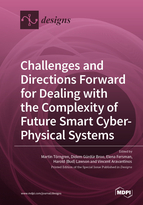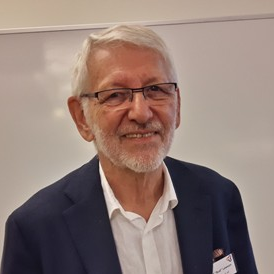Challenges and Directions Forward for Dealing with the Complexity of Future Smart Cyber–Physical Systems
A special issue of Designs (ISSN 2411-9660). This special issue belongs to the section "Smart Manufacturing System Design".
Deadline for manuscript submissions: closed (30 September 2018) | Viewed by 40412
Special Issue Editors
Interests: Cyber–Physical Systems (CPS) and systems engineering; design methodology; model based engineering incl. model and tool interoperability; architectures of embedded and cyber–physical systems; co-design of control and embedded computer systems; system and functional safety; autonomous machines and trustworthy AI; innovation eco-systems; life-long learning and education
Interests: Cyber–Physical Systems; interoperability; tool integration; data analytics; data visualisations; visual analytics
Special Issues, Collections and Topics in MDPI journals
Department of Machine Design, KTH Royal Institute of Technology, 100 44 Stockholm, Sweden
Interests: modeling and analysis of Cyber-Physical Systems; knowledge representation, knowledge management and decision support
Interests: complex systems; systems thinking; systems engineering; software engineering
Special Issue Information
Dear Colleagues,
A key aspect of Cyber-Physical Systems (CPS) is their potential for integrating information technologies, operational technologies (in terms of embedded systems and control systems), and physical systems, to form new or improved functionalities. CPS, thus, draws upon advances in many areas. This positioning provides unprecedented opportunities for innovation, within and across existing domains. However, at the same time, it is commonly understood that we are already stretching the limits of existing methodologies.
In embarking towards CPS with such unprecedented capabilities it becomes essential to improve our understanding of CPS complexity and how we can deal with it. Complexity has many facets including complexity of the CPS itself, of the environments in which the CPS acts, and in terms of the organizations and supporting tools that develop, operate and maintain CPS.
The primary objective of this Special Issue is to provide a forum for researchers and practitioners to exchange their latest achievements and to identify critical issues, challenges, opportunities and future directions for how to deal with the complexity of future CPS. Contributions covering methods, tools, architectures, foundational aspects as well as organizational and other complexity-related aspects are welcomed.
Dr. Vincent Aravantinos
Ms. Didem Gürdür
Dr. Elena Fersman
Prof. Dr. Martin Törngren
Prof. Dr. Harold (Bud) Lawson
Guest Editors
Manuscript Submission Information
Manuscripts should be submitted online at www.mdpi.com by registering and logging in to this website. Once you are registered, click here to go to the submission form. Manuscripts can be submitted until the deadline. All submissions that pass pre-check are peer-reviewed. Accepted papers will be published continuously in the journal (as soon as accepted) and will be listed together on the special issue website. Research articles, review articles as well as short communications are invited. For planned papers, a title and short abstract (about 100 words) can be sent to the Editorial Office for announcement on this website.
Submitted manuscripts should not have been published previously, nor be under consideration for publication elsewhere (except conference proceedings papers). All manuscripts are thoroughly refereed through a single-blind peer-review process. A guide for authors and other relevant information for submission of manuscripts is available on the Instructions for Authors page. Designs is an international peer-reviewed open access semimonthly journal published by MDPI.
Please visit the Instructions for Authors page before submitting a manuscript. The Article Processing Charge (APC) for publication in this open access journal is 1600 CHF (Swiss Francs). Submitted papers should be well formatted and use good English. Authors may use MDPI's English editing service prior to publication or during author revisions.
Keywords
-
methodologies for dealing with complexity
-
analyzing or characterizing complexity of CPS
-
what are the key facets of the cyber- vs. the physical vs. cyber-physical complexity?
-
foundational theories for CPS engineering
-
composability approaches for CPS
-
systematic approaches for dealing with uncertainty
-
systematic approaches for dealing with interfaces and interrelations
-
dealing with trustworthiness and trade-offs (e.g. safety vs. security vs. availability vs. cost)
-
reconciling software and hardware processes and life-spans
-
smartness of CPS and complexity management, leveraging AI
-
robustness of CPS, dealing with AI and complex environments
-
cyber-physical systems of systems-ensuring proper interactions at the SoS level
-
managing organizational complexity









